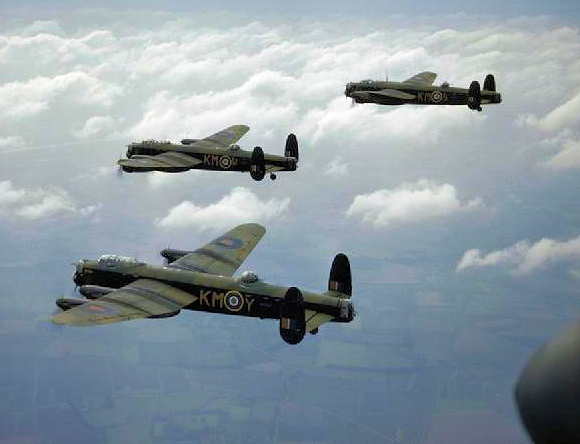The four-engine heavy Avro Lancaster was one of the most important and effective strategic bombers of the Royal Air Force in the Second World War.
The vehicle was developed from the Avro 679 Manchester twin-engine heavy bomber and designed by engineer Roy Chadwick; the first prototype took off for the first time on 9 January 1941 – obtaining good results – and entered active service starting from February 1942. The main users of the aircraft during the conflict were the Royal Air Force, the Royal Canadian Air Force and the Royal Australian Air Force.
Overall, more than 7,000 examples were built, and during the war more than 3,000 were shot down (according to estimates).
The British will use the vehicle until the early fifties, while the Canadians until 1964.
In my view it is important to remember that the Lancastrians were able to carry the 22,000 lb (10,000 kg) “Grand Slam earthquake bomb” and the 12,000 lb (5,400 kg) “Tallboy earthquake bomb”. However, even the Short S.29 Stirling e Handley Page Halifax they were capable of carrying bombs weighing almost 6 tons1.
It should be remembered that the theory of strategic air attack was developed in the United Kingdom at the end of the First World War and in the following years. Most likely it was a product of the creation, on 1 April 1918, of the Royal Air Force as an autonomous weapon into which the former air weapons of the British Army and Royal Navy merged.
Nonetheless, at the outbreak of the Second World War, the bombing by the Royal Air Force was limited to more demonstrative actions: the dropping of propaganda leaflets on German territory and occasional raids against naval targets. Furthermore, “the French, who feared the danger of retaliatory bombing even more than the British, opposed the use of French bases by the British bomber command, being moreover convinced – like the Germans – that bombers had above all a tactical value and should therefore work in close cooperation with land forces.2”
This situation changed radically with the advent of Winston Churchill as prime minister. With the new premier, a real strategic air offensive against Germany began.
According to estimates, the Bomber Command, commanded by Arthur Travers Harris from 22 February 1942 to 15 September 1945, of the Royal Air Force – with all the aircraft at its disposal – carried out 389,809 war flights during which about 970,369 scattered over European targets tons of bombs. Avro Lancasters alone flew 156,000 sorties dropping 618,378 tons.
The Lancasters, substantially, together with the other bombers took part in all the strategic raids on the German centres, causing devastation and annihilation. In this regard, we can recall the Gomorrah operation (July 25-August 3, 1943), the Kassel bombing (October 22, 1943) and the Dresden bombing (February 13-15, 1945).
The bomber attacks took place according to the technique of maximum concentration in time and space, with mixed and alternating launches of high explosive bombs and hundreds of thousands of incendiary pieces which caused a terrifying physical phenomenon, the so-called “firestorm”. 3.
It should be remembered that the four-engine Lancaster bombed heavily also the Italian cities (especially those of Northern Italy).
Among the most important enterprises of these strategic bombers there was certainly the operation Chastise (punishment). In the night between 16 and 17 May 1943 an attack was carried out against the German dams on the Eder, Sorpe and Mohne rivers by the 617th squadron of the Royal Air Force led by Lieutenant Colonel Guy Gibson; in that event “bouncing bombs” were used (photo – designed by Barnes Wallis). The Mohne and Eder dams were destroyed. However, the excellent raid was paid for with the loss of 8 of the 19 Avro Lancasters that took part in it (see article “The strategic use of water for defensive purposes”).
After the war, the aircraft was used by various air forces, including the Argentine and the French Aéronavale.
The four-engine Avro Lancaster had a wingspan of 31.09 m, height 6.25 m and length 21.13 m. The empty weight was 16738 kg, while loaded 24948 kg.
Engine: 4 Rolls Royce Merlin XX V-12, power 1280 HP. The maximum speed was 454 km/h (at 3962 m), while the cruising speed was 320 km/h. The ceiling height was 6500 m.
Armament was 7.7 mm Browning Mark II machine guns. In addition, the bomber could carry up to 6400 kg of bombs (maximum normal load).
The vessel could count on a crew of 7 men.
1 See G. Bonacina, Il Lancaster, in Storia Illustrata n°130,1968, p.64
2 BH Liddel Hart, Military History of the Second World War. Armies, fronts and battles, Mondadori, Milan, 2021, p.792.
3 See G. Bonacina, Il Lancaster, in Storia Illustrata n°130, 1968, p.64
Photo: RAF / IWM
